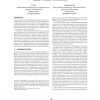KBS
2000
15 years 12 days ago
2000
This paper argues that AI planning is a technology ripe for use on real world problems as shown by a number of current applications. An
96
Voted
CHI
2010
ACM
15 years 26 days ago
2010
ACM
Researchers have detailed the importance of routines in how people live and work, while also cautioning system designers about the importance of people's idiosyncratic behavi...
WCE
2007
15 years 1 months ago
2007
—Partial Differential Equations (PDEs) play an essential role in modeling real world problems. The broad field of modeling such systems has drawn the researchers’ attention for...
SIGMOD
2005
ACM
15 years 6 months ago
2005
ACM
In this paper, we examine how active database technology developed over the past few years has been put to use to solve real world problems. We note how the technology had to be e...
101
click to vote
ATAL
2007
Springer
15 years 6 months ago
2007
Springer
Canonical problems are simplified representations of a class of real world problems. They allow researchers to compare algorithms in a standard setting which captures the most im...
87
Voted
IAT
2008
IEEE
15 years 7 months ago
2008
IEEE
The use of rational agents for modelling real world problems has both been heavily investigated and become well accepted, with BDI Logic being a widely used architecture to repres...
108
click to vote
ICPR
2000
IEEE
16 years 1 months ago
2000
IEEE
We studied a number of measures that characterize the difficulty of a classification problem. We compared a set of real world problems to random combinations of points in this mea...

